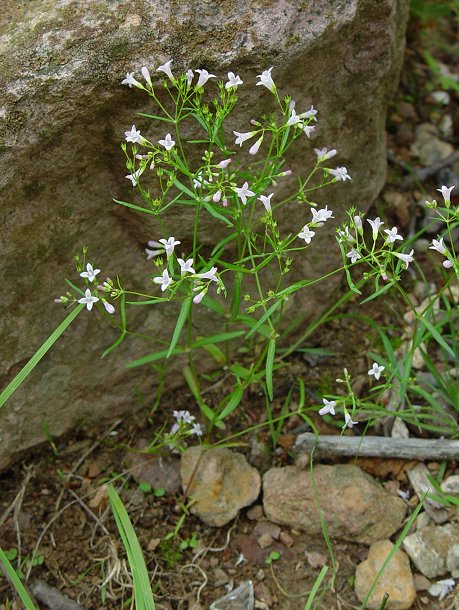Houstonia longifolia Gaertn.
Long-Leaved Bluets

Native
CC = 5
CW = 5
MOC = 48
© DETenaglia
Houstonia longifolia Gaertn.Long-Leaved Bluets | |
 |
Native CC = 5 CW = 5 MOC = 48 |
© DETenaglia |
|
Family - Rubiaceae Habit - Perennial forb with fibrous roots, sometimes with threadlike rhizomes. Stems - Ascending to erect, to 30 cm, often multiple from the base, simple or branching above, 4-angled, glabrous or minutely hairy, especially at the nodes, often reddish below. Leaves - Opposite and basal, not succulent. Stipules 1.0-3.5 mm long, triangular to ovate, bluntly or sharply pointed, entire along the margins. Basal leaves petiolate, the petioles to 1 cm long, the blades oblong to spatulate or lanceolate, tapering at base, glabrous, reddish below, green above. Stem leaves sessile, 5-40 mm long, 0.5-6.0 mm wide, linear to narrowly oblong, bluntly pointed at the tip, narrowly angled or tapered at the base, the margins entire and often roughened or minutely hairy, flat or sometimes slightly rolled under, the upper surface glabrous or sparsely short-hairy, the undersurface glabrous, the venation with only the midvein observable.
Inflorescence - Flowers distylous, terminal and sometimes also from the upper leaf axils, in small clusters of 2-7, these sometimes grouped into small panicles, the flower stalks 2-8 mm long, appearing glabrous but heavily glandular under magnification.
Flowers - Calyx lobes 4, 1.0-2.5 mm long, up to 1/2 as long as the adjacent corolla tube, narrowly triangular. Corollas funnelform, 4-lobed, white to to pink or bluish-tinged, lacking a ring of contrasting color in the throat, externally glabrous, internally pubescent in most of the tube, sometimes sparsely so, the tube 4-5 mm long, the lobes 2-4 mm long, triangular. Stamens 4, adnate near base of corolla tube. Anthers pale-yellow, 1 mm long. Filaments very short (0.1 mm). Style filiform, glabrous, 6-7 mm long, slightly exserted. Stigmas 2, globose. Hypanthium 1 mm long.
Fruits - Capsules 2.0-2.5 mm long, 2.0-2.5 mm wide, subglobose to ovoid, not or only slightly flattened, partially inferior, sometimes slightly notched at the tip, glabrous or nearly so. Seeds 0.8-1.4 mm long. Flowering - April - July. Habitat - Upland forests, savannas, upland prairies, glades, ledges and tops of bluffs, pond margins, streambanks, pastures, lawns, railroads, and roadsides. Origin - Native to the U.S. Lookalikes - H. nigricans. Other info. - In Missouri this little plant is found in the southeastern half of the state. Beyond Missouri its range extends throughout much of the eastern half of the U.S. and into Canada. The plant is common in the parts of the state where it grows. It is identified by its small, 4-lobed flowers, which are usually white, and narrow opposite leaves. It strongly resembles H. nigricans and can be difficult to distinguish from that species. Different authors have circumscribed the two species somewhat differently. Characters commonly believed to point to H. longifolia include interpetiolar stipules which lack bristles, somewhat wider leaves which lack axillary fascicles, and longer flower stalks (2-8 mm). These characters may be unreliable or misleading in some cases, with appearances being dependent on the age of the plant. The same can be said of the infraspecific forms which have sometimes been defined within the species. Photographs taken on Taum Sauk Mountain, MO., 5-31-03 (DETenaglia); also at Valley View Glade Natural Area, Jefferson County, MO, 4-26-2012, and Shaw Nature Reserve, Franklin County, MO, 5-20-2022 (SRTurner). |